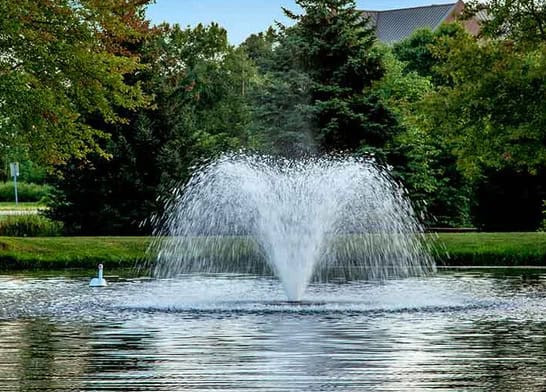Submersible fountain pumps play a crucial role in maintaining the proper functioning of various aquatic systems, such as ponds.
Buy submersible fountain pumps as these pumps serve as the heart of the pond, ensuring sufficient water flow for fountains, supporting the well-being of fish and filtering bacteria, and maintaining a healthy, oxygenated environment.
Understanding Submersible Pumps and Their Significance in Pond Filtration
The Role of Submersible Fountain Pumps in Pond Filtration
Submersible Fountain pumps are essential components of pond filtration systems that maintain the aquatic environment’s overall health and stability. By continuously circulating water, these pumps facilitate vital processes such as oxygenation, filtration, and water movement, which are critical for supporting aquatic life and promoting ecological balance.
The IoT’s Contribution to Learning about Submersible Pumps
In the digital age, educational platforms like YouTube have become valuable resources for understanding complex topics like submersible pumps. The integration of the Internet of Things (IoT) has enabled the creation of visual tools and tutorials that offer comprehensive insights into the functioning and components of submersible pumps.
Identifying and Resolving Common Problems with Submersible Pumps
The Impact of Pump Malfunctions on Pond Ecosystems
Disrupting a submersible pump’s operation can severely affect the entire pond ecosystem. Apart from affecting the aesthetics of fountains and water features, a malfunctioning pump can deprive fish and filtering bacteria of fresh, oxygenated water, leading to potential harm and imbalances in the pond’s ecology.
Visual Inspection for Pump Problems
Performing regular visual checks can help diagnose and address submersible fountain pump issues promptly. Approximately eighty percent of pump problems can often be resolved with simple interventions, saving time and money.
Essential Questions for Visual Diagnosis
- Was the equipment installed properly with proper electrical connections?
- Is the water level within the recommended range? Pumps cannot run dry!
- Is the circuit breaker in the correct position? (Note: The issue may require more than a simple fix.)
- Are there any signs of damaged wiring?
- Is there any obstruction in the water flow around the pump, skimmer, or filter?
Safety Precautions
It is crucial to prioritize safety when dealing with electricity and water. Before attempting any visual checks or maintenance of the submersible pump, always turn off the power supply to the pump. Never work on the pump, components, parts, or wires if electricity still flows.
Cleaning Out Clogged Debris for Easy Repairs
One of the primary reasons for submersible pump failure is irregular maintenance leading to debris accumulation. Cleaning out clogged debris can often resolve pump issues effectively. Clogged up pumps do not allow water to flow through and will burn out the pump, just as running the pump dry will.
Safe Removal of the Pump from Water
Before performing any maintenance on the submersible pump, it is essential to ensure electrical safety by safely removing the pump from the water. This process involves carefully disconnecting the power supply and removing the pump from the pond. Submersible pumps are designed to operate underwater, and removing them from the water eliminates the risk of electrical shocks or accidents during maintenance. Properly handling the pump during removal prevents damage to the unit and ensures that it can be worked on safely on dry ground.
Identifying and Clearing Clogs
Clogs are a common issue that can hinder the performance of submersible pumps. To address this problem, it is crucial to identify the potential points of obstruction. Start by checking the tubing connected to the pump for any debris or blockages that may restrict water flow. Additionally, inspect the filters and impellers, as these components are often prone to accumulating debris. Clearing impellers requires the impeller cover be removed, but how to do so varies from pump to pump. Merely washing the outside of the pump will not clear the impeller of debris. Clearing these clogs allows water to flow freely, improving the pump’s efficiency and preventing unnecessary strain on the motor.
Power Check and Reinstallation
After addressing clogs and completing maintenance tasks, it is vital to double-check the power supply before returning the pump to the water. Ensuring the pump is properly reconnected to a reliable power source helps prevent any issues during reinstallation. Confirming that the electrical connections are secure and the power is functioning correctly ensures the pump will operate as intended once submerged back into the pond. This power check minimizes the risk of damage due to electrical problems, promoting a safe and effective pump operation. As with other outdoor products, a GFCI is required for safety.
Knowing When to Replace Submersible Pumps
Prioritizing Safety When Replacing Pumps
Working with electricity near the water requires utmost caution. If unsure about handling replacement tasks, it is best to seek assistance from a qualified electrician or professional.
Indicators for Pump Replacement
Recognizing the signs that a submersible pump needs replacement is crucial to prevent potential hazards and ensure the pond’s proper functioning.
Incorrect Installation
The importance of proper pump installation cannot be overstated, especially when dealing with submerged electrical components. An improper installation can lead to electrical faults, short circuits, or electric shocks, endangering humans and aquatic life. Furthermore, the pump’s warranty may become void if not installed by a professional, resulting in potential financial losses for the pond owner.
To ensure safe and efficient pump operation for 220-volt units, it is crucial to have a qualified electrician handle the installation. Their expertise ensures the pump is correctly wired and grounded, reducing the risk of electrical hazards. Additionally, a professional installation ensures that the pump is appropriately sized and positioned to achieve optimal water flow and filtration.
Persistent Circuit Breaker Trips
Frequent circuit breaker tripping is a red flag indicating underlying issues with the submersible pump. When the circuit breaker trips frequently, it disrupts the pump’s operation, leading to inadequate water circulation and filtration. Ignoring this problem can lead to further electrical complications and permanently damage the pump’s motor.
There are several reasons why a submersible pump may cause the circuit breaker to trip. It could be due to a damaged power cord, an overloaded motor, or a short circuit within the pump’s internal components. If not addressed promptly, these issues can escalate and pose safety hazards.
When faced with persistent circuit breaker trips, it is essential to consult a professional to diagnose the problem accurately. In some cases, minor repairs or component replacements may resolve the issue. However, if the problem is recurrent and cannot be rectified, replacing the pump becomes necessary to prevent electrical problems and maintain a healthy pond environment.
Dry Running Damage
Submersible pumps rely on water for cooling and lubrication of their internal components. When a pump runs dry for even a short period, it can lead to irreversible damage to the motor and impellers. Dry running causes excessive friction and heat buildup, which can warp or deform critical parts of the pump. Additionally, the absence of water circulation hinders heat dissipation, exacerbating the problem.
If a submersible pump has been running without water, its performance will likely be compromised. The pump may experience reduced water flow, decreased filtration efficiency, and increased energy consumption. In severe cases, the pump may cease altogether, rendering it irreparable.
Monitoring the water level regularly and ensuring the pump is always submerged during operation is crucial to prevent dry running damage. Implementing water level sensors or automatic shut-off mechanisms can provide extra protection against dry-running incidents.
Overheating Pump
An overheating submersible pump is a clear indication of malfunction and a sign that immediate action is required. Pumps are designed to operate within specific temperature limits, and when these limits are exceeded, the pump’s performance is compromised, leading to potential breakdowns or failures.
Several factors can contribute to pump overheating. Common culprits are blockages or clogs in the intake or impeller, excessive friction due to dry running, motor issues, or electrical malfunctions. Overheating affects the pump’s efficiency but can also cause damage to critical internal components, shortening the pump’s overall lifespan.
If an overheating pump is detected, it is essential to shut off the power immediately to prevent further damage. Identifying and addressing the root cause of the overheating is crucial. Depending on the damage’s extent and the pump’s age, replacement may be the most viable solution to ensure reliable and safe pond filtration.
Unexplained Noises
Unusual and loud noises emanating from the submersible pump during operation cause concern. While some pump noise is expected, particularly in older units, loud and unexplained sounds can indicate internal damage or mechanical failures. These noises can be rattling, grinding, squealing, or knocking, and they may persist even after attempts to remove clogs or debris.
Internal damage to the pump’s motor, impellers, or, when included, bearings can generate these unusual sounds. Sometimes, the damage may be irreversible and difficult to repair, making replacement the most practical and cost-effective solution.
Ignoring strange noises from the pump can exacerbate the issue, potentially leading to complete pump failure or water contamination. Therefore, immediate action is necessary to diagnose the problem accurately and determine whether replacement is required to maintain a healthy pond ecosystem and prevent further complications.
Submersible pumps are vital components in pond filtration systems, playing a central role in maintaining a healthy aquatic environment. Understanding their operation and the potential problems they may encounter allows pond owners and maintenance personnel to take appropriate measures to ensure continuous and efficient functioning. Regular visual inspections, proper maintenance, and timely replacements when necessary are essential to extend the lifespan of submersible pumps and safeguard the well-being of aquatic ecosystems. By prioritizing safety and adhering to recommended maintenance practices, pond enthusiasts can enjoy the beauty of their water features while preserving the natural balance of their ponds for years to come.
Explore our website to check our submersible fountain pumps collection.
Frequently Asked Questions
How often should I visually inspect my submersible pump for potential issues?
Regular visual inspections are essential for the proper maintenance of your submersible pump. It is recommended to conduct visual checks at least once a month, especially during peak usage periods or in challenging weather conditions. If you see the flow drop dramatically something is wrong, and you should shut off the pump and inspect.
Can I conduct submersible pump maintenance without turning off the power?
No, performing maintenance on a submersible pump while it is still connected to the power supply is unsafe and strongly discouraged. Always turn off the power and unplug the pump from the electrical source before handling any maintenance tasks.
How do I know if my submersible pump needs replacement?
Several indicators suggest that your submersible pump may require replacement. Frequent circuit breaker tripping, persistent overheating, or unexplained loud noises during pump operation are signs of potential internal damage warranting pump replacement. Again, if the flow of water decreases suddenly something is wrong, typically a clog or damaged impeller.
What can I do if my submersible pump gets clogged frequently?
Frequent clogging is a common issue that can disrupt submersible pump performance. To address this problem, consider implementing regular maintenance and cleaning routines. Check and clean the tubing, filters, and impellers regularly to remove debris that might obstruct water flow. Larger pumps for floating fountains often include filter baskets or pump socks to keep out debris, but pump socks can become clogged, also. Water must flow through the pump at all times.


